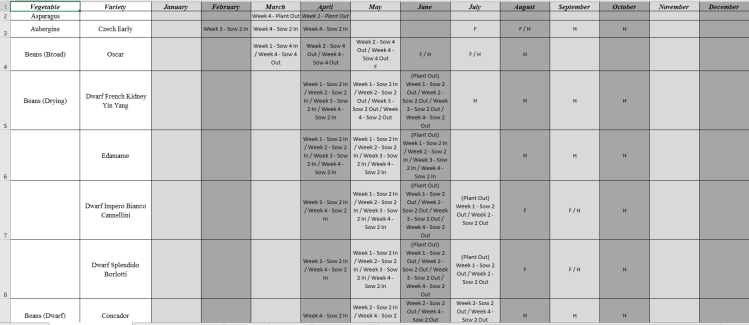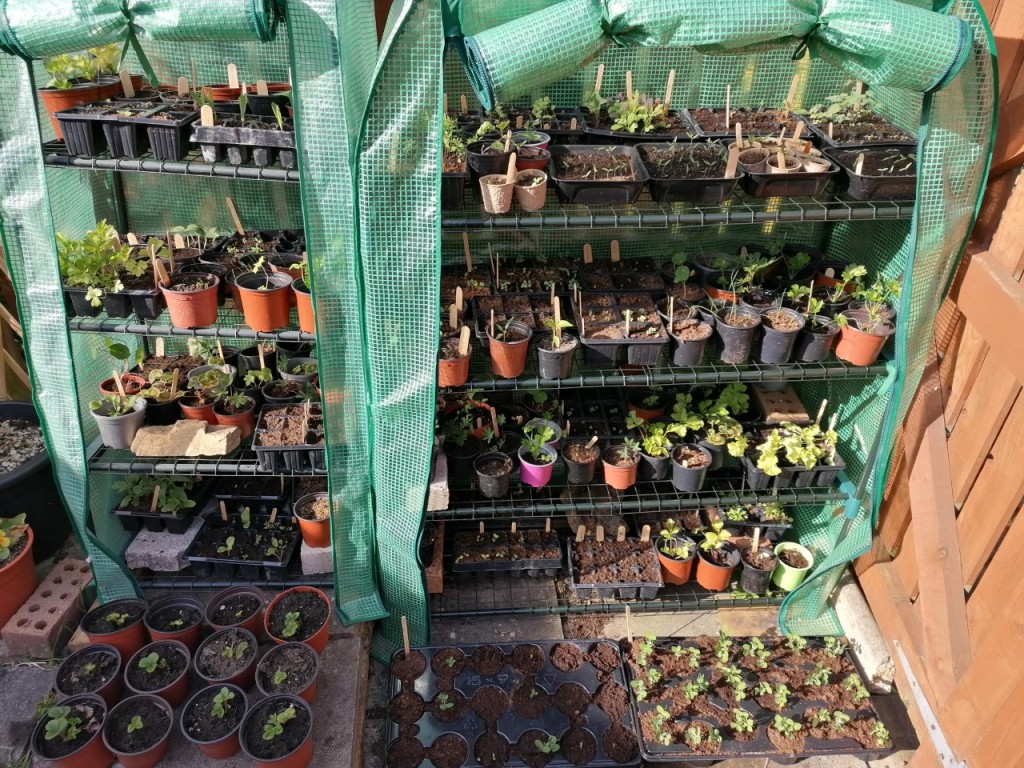One of the most common questions I get from fellow garden enthusiasts is how do you know when is the best time to plant x and y? Unfortunately, there is no real straight answer as so much depends on several factors. These include: are you using raised beds or planting in the ground; have you prepared your soil; what is the type of variety or cultivar you are using; how sheltered or elevated is your site; and so on?
All these factors may seem daunting and can quickly get confusing – this is where good organisation and a bit of research can help!

Just as an example, let us look at broad beans. You can see in the two left hand columns that I have the species (i.e. broad beans) and the variety next to it (Oscar). The subsequent columns stand for each month of the year, beginning with January. Now, the seed packet says these beans can be sown indoors beginning in February but, as we are in the north of the country and these packets are produced as a national recommendation, I automatically tend to add on a few weeks to the beginning of the growing guideline. I have prepared the soil in advance with plenty of compost and well-rotted manure and they will be going in a sheltered but sunny spot. However, I am also planting these directly in the ground, which means the soil will be much cooler than if it was in a raised bed. So, if something says sow from mid-February, I will usually wait to sow it until early- or mid-March, just to be on the safe side and allow the soil to warm up a bit more. If I was planting in a raised bed or in a cold frame, I could definitely sow out from mid-February.
I also do not sow everything at once – this is the surest way to get a glut instead of being able to enjoy these delicious veggies for the entirety of their growing season. That is why I have limited the amount of seeds I sow per session and have them spaced 2-3 weeks apart. My belief is that sowing little and often will always ensure a bountiful and longer harvest period.
Now, back to the calendar! For broad beans, I have it scheduled to sow in 4 plants during the first and fourth week of March, then – as the soil will start to warm and dry from the periods of cold, heavy winter rain – I will then move to sowing them outside in their final positions beginning in April. Note, this is different from planting them out – planting out implies that you are merely moving a plant that has been sown indoors until it’s final position outside – sowing out means you are planting a new seed outdoors rather than starting it off inside. As you can see from the months of April and May, I am still sowing these in gradual stages to lengthen the harvest season.
I also record the time when it is expected to flower (F) – note, this is only really done if the seed packet provides this information, if not I don’t bother to record it. This is just to give me a guideline for the plant’s growth and vegetable development so I can ensure that it is on track and I know to look out for any irregularities. I then also record when I can begin to harvest (H) if all goes according to plan.
This may seem a little OTT, but I promise you can never be too organised when it comes to growing! I usually take advantage of the quieter winter months to assemble my growing calendars for the upcoming planting season, but you can start something like this at any time. Just look at the back of your seed packet for advice and, if in doubt, trust your instincts. If you think it is too cold to plant something outside, then it probably is.
- If you would like a more general idea of what to plant at this time of the year, this is what I have been up to for the month of April:
- Vegetables and Fruits Sown Inside:
- Aubergine, var. Czech Early
- Drying Beans, var. Kidney Yin Yang, Edamame, Imperio Bianco Cannellini, and Splendido Borlotti
- Dwarf Beans, var. Concador
- French Climbing Beans, var. Blue Lake
- Runner Beans, var. Red Rum
- Calabrese Broccoli, vari. Monclano
- Chinese Sprouting Broccoli, var. Brokali Apollo
- Purple Sprouting Broccoli, var. Red Admiral
- Brussels Sprouts, var. Continuity Mix
- Autumn Cabbage, var. Primo II
- Spring Cabbage, var. Durham Early
- Summer Cabbage, var. Red Drumhead
- Cauliflower, var. Chinese Sweet Sprouting
- Celeriac, var. Monarch
- Celery, var. Blush
- Chard, var. White Silver
- Comfrey, standard species
- Cucamelon, var. Melothria
- Cucumber, var. Burpless Tasty Green
- Kale, var. Black Magic
- Leeks, var. Below Zero F1 and Pancho
- Melon, var. Outdoor Wonder and Arava
- Pepper, var. Jalapeno
- Pepper, var. Summer Salad Improved Mix
- Pumpkin, var. Amazonka and Rocket
- Spinach, var. Amazon
- Squash (Summer), var. F1 Atena, All Green Bush, and Summer Mix
- Squash (Winter), var. Avalon, Buffy Ball, Honeyboat, Potimarron, and Sweet Dumpling
- Sweetcorn, var. Swift F1 Hybrid
- Tomato, var. Gardener’s Delight and Supersweet
- Vegetables and Fruits Sown Outside:
- Beetroot, var. Pablo
- Carrots, var. Flyaway and Paris Market Atlas
- Cabbage (Winter), var. Ormskirk
- Lettuces, var. Lollo Biondi and Red Salad Bowl
- Mustards, var. Oriental Mix
- Pak Choi, var. Ivory F1
- Parsnips, var. Tender and True
- Peas, var. Petit Pois and Hurst Green Shaft
- Radish, var. Salad Mix
- Salsify, var. Scorzobianca
- Spring Onions, var. White Lisbon
- Swede, var. Invitation
- Turnips, var. Milan Purple Top
- Vegetables and Fruits Planted Outside:
- Asparagus
- Blackberry
- Broad Beans
- Garlic, var. Flavor
- Onions, var. Red Baron and Centurion
- Pineberry
- Potatoes, var. Purple Eye and Charlotte
- Raspberry
- Shallots, var. Red Sun
- Tayberry
- Vegetables and Fruits Sown Inside:
In addition to the fruits and vegetables, I have also sown a number of flowers, like: Antirrhinum, Aquilegia, Aster, Borage, Chrysanthemum, Dahlia, Delphinium, Echinacea, Geranium, Lavender, Linum, Lupin, Marigold, Nasturtium, Poppy, Sage, Shoo-Fly, Stock, Sunflower, Verbena, and Zinnia.
As always, if you have any questions feel free to drop one in the comments section.
Happy springtime planting!



Hi, do you grow aubergine outside or in a greenhouse!?
LikeLike
Hi, thanks for reading! I grow them in a greenhouse – or in my case, it’s more like a pop-up polytunnel. We’re not allowed greenhouses on our plot but they do need warmth, so any sort of warm covering should do.
Hope this helps!
LikeLiked by 1 person
I planted mine in greenhouse. Thank you for the answer!
LikeLike